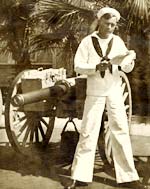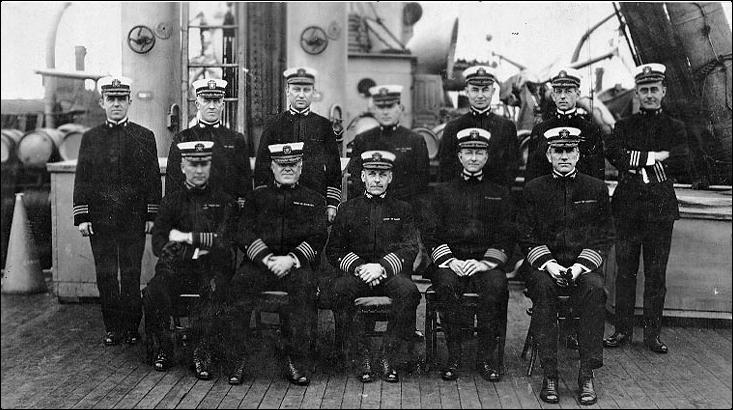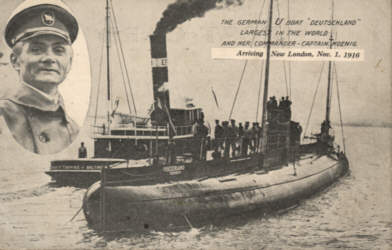 Ebert Philpott in uniform. (OSA)
Ebert Philpott in uniform. (OSA)
Sailor Helps Mine the North Sea
In 1916 Ebert Philpott, a 21 year old from Bullards, just north of Bandon, traveled to the Portland recruiting station to enlist as an apprentice seaman in the Navy. Philpott trained for several months at the Naval Training Station on Goat Island in the San Francisco Bay. After a brief stint aboard the USS Alabama, he saw duty as a fireman second class on the minelayer USS Canonicus.
The naval mine became a primary Allied weapon against the German submarines during World War I. The cylindrical mines measured approximately 36 inches wide and were packed with 300 pounds of explosives. (
View image of loading mines onto a ship.)
 Senior officers of Mine Squadron One in the North Sea in 1918. Philpott's commanding officer on the Canonicus, Captain Thomas L. Johnson, stands 2nd from left. (Photo #NH 52995, www.history.navy.mil)
Senior officers of Mine Squadron One in the North Sea in 1918. Philpott's commanding officer on the Canonicus, Captain Thomas L. Johnson, stands 2nd from left. (Photo #NH 52995, www.history.navy.mil)
By late in the war, advances in the firing devices on the moored mines made it feasible to plan a bold countermeasure against the U-boats.
Over a five month period in 1918, American and British minelayers planted over 70,000 mines in the North Sea in a line extending 250 miles from Scotland to Norway. While not completed before the end of the war, the North Sea mine barrage lowered the effectiveness of the German submarines.
Resting Easy on 900 Explosive Mines
The Canonicus, with Philpott aboard, laid 11,000 mines in the North Sea area during the effort. With the end of the war, the ship saw duty transporting soldiers back to the U.S.
To Philpott's dismay, the Navy assigned him to a new duty away from the Canonicus. Philpott sent this letter to his parents soon after the Armistice was signed, as his now former ship sailed home:
Naval Blockade Theory
Despite Philpott's effort to reassure his parents about his relative safety on a mine laying ship, German submarines, or U-boats (short for undersea boat in German), caused great damage to merchant shipping during World War I. Before the start of war, experts thought submarines were poor weapons for naval blockades of enemy countries. Blockades often involved taking aboard the crew of a captured ship as prisoners. Also, sailors from the attacking ship often would man the enemy ship after it was captured. But submarines were incredibly cramped, having barely enough space to house a crew for its own operation. With no room for prisoners or additional crew to man captured vessels, they were deemed ineffective for blockades.
 Unarmed submarine freighter Deutschland, described on a postcard as "largest in the world," arrives at a Connecticut harbor in 1916. The U.S. was still neutral at the time. Six months later the vessel was commissioned into the German Navy after the resumption of unrestricted submarine warfare. In the next months, it traveled over 9,000 miles, sank 19 ships, and shelled targets ashore on the Azores.
Unarmed submarine freighter Deutschland, described on a postcard as "largest in the world," arrives at a Connecticut harbor in 1916. The U.S. was still neutral at the time. Six months later the vessel was commissioned into the German Navy after the resumption of unrestricted submarine warfare. In the next months, it traveled over 9,000 miles, sank 19 ships, and shelled targets ashore on the Azores.
Unrestricted Submarine Warfare
However, in February 1915, the German government rejected the prevailing views on the use of submarines. In what became known as unrestricted submarine warfare, leaders decided rather than attempt to capture merchant ships, the U-boats would simply sink them. No attempt would be made to rescue merchant sailors. The German government declared a war zone around the British Isles and announced their intention to sink without warning any Allied merchant ship.
By September the U-boats had hit 50 ships. One of them, the ocean liner Lusitania caused particular outrage in America after it went down in May 1915. Nearly 1,200 lives were lost, including 128 Americans. Since President Woodrow Wilson earlier had declared the U.S. to be officially neutral in the war, the loss of American life caused many to call for war against Germany. Wilson sent a strong protest to the German government, which eventually suspended the attacks.
U-boat Marauders Nearly Succeed
But by February 1917, the strategic equation had changed enough that the German government was willing to risk bringing the U.S. into the war. The goal was to starve Great Britain out before the Americans entered. The new policy was even more deadly than the first: all Allied and now neutral ships, including those flying the U.S. flag, would be sunk on sight.
The strategy nearly succeeded. By the time America declared war in April, the U-boats had sunk over 1,000 merchant ships and Great Britain was within six weeks of starvation. Ultimately, the new practice of deploying the merchant ships in convoys protected by armed escorts doomed the U-boat warfare strategy. Convoys made the ships much less easy to pick off and the escorts made the task much more dangerous for the U-boats. As a result, the merchant ship losses dropped quickly and a reliable supply route across the Atlantic helped to turn the tide against Germany. American troop ships also benefited from the use of convoys as the "doughboys" made their way to war.
On to a Minesweeper
Hoping to return home as soon as possible, Philpott put in an application to be dismissed from the Navy in late 1918. But the Navy had other plans for him. The work of minesweepers continued long after the end of the war. They were needed to help clear mines from the harbors and coastal waters of Europe so that the nations of the continent could begin to rebuild their economies. Philpott would serve for two more years before his discharge in December 1920. Much of that time he spent on the minesweeper USS Woodcock working as a water tender.
Notes
(Oregon State Defense Council Records, Personal Military Service Records, World War I, Box 2, Coos County, School District No. 21; Oregon Military Department Records, World War I Service Cards)